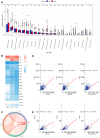A circadian rhythm-related gene signature for prognosis, invasion and immune microenvironment of breast cancer
- PMID: 36685904
- PMCID: PMC9849377
- DOI: 10.3389/fgene.2022.1104338
A circadian rhythm-related gene signature for prognosis, invasion and immune microenvironment of breast cancer
Abstract
Background: Circadian dysregulation is linked to the onset and progression of cancer, but current knowledge of the role of circadian rhythm-related genes (CRRGs) in breast cancer (BC) is limited and incomplete. The purpose of this study was to investigate the potential role and immune-related prognostic significance of CRRGs in BC. Methods: The Cancer Genome Atlas breast cancer (TCGA-BRCA) genetic data were combined with 1369 CRRGs to create a model of BC prognosis-related CRRGs. To validate the model's predictive power in TCGA and other external datasets, the Kaplan-Meier survival curve and receptor operation characteristic curve were plotted. The relationship between CRRGs model and gene enrichment pathways, immune cell infiltration, and differences in patient response to immune checkpoint inhibitors (ICIs) therapy was then discussed. Results: A CRRG-based eighteen-gene model was developed that accurately predicted the survival time of BC patients. Based on this model, BC patients can be classified as high or low risk. The high-risk group has negative immune cell infiltration (such as macrophages M0 and M2) and a poor therapeutic response to ICIs due to lower immune checkpoint gene expression. Furthermore, TCF7 and IFNG were found to be strongly associated with immune checkpoints in CRRGs model. Conclusion: The 18 CRRGs may be useful in assessing the prognosis of BC patients, studying immune infiltration, and developing more effective immunotherapy strategies.
Keywords: TCGA; breast cancer; circadian rhythm; immunity; prognosis.
Copyright © 2023 Wang, Liu, Wang and Zhang.
Conflict of interest statement
The authors declare that the research was conducted in the absence of any commercial or financial relationships that could be construed as a potential conflict of interest.
Figures








Similar articles
-
A Circadian Rhythm-related Signature to Predict Prognosis, Immune Infiltration, and Drug Response in Breast Cancer.Curr Med Chem. 2025;32(3):608-626. doi: 10.2174/0109298673320179240803071001. Curr Med Chem. 2025. PMID: 39279697
-
Circadian rhythm-related genes index: A predictor for HNSCC prognosis, immunotherapy efficacy, and chemosensitivity.Front Immunol. 2023 Mar 10;14:1091218. doi: 10.3389/fimmu.2023.1091218. eCollection 2023. Front Immunol. 2023. PMID: 36969232 Free PMC article.
-
Identification of chromatin remodeling-related gene signature to predict the prognosis in breast cancer.Clin Exp Med. 2025 May 3;25(1):137. doi: 10.1007/s10238-025-01661-8. Clin Exp Med. 2025. PMID: 40317384 Free PMC article.
-
Construction of a circadian rhythm-related gene signature for predicting the prognosis and immune infiltration of breast cancer.Front Mol Biosci. 2025 Feb 6;12:1540672. doi: 10.3389/fmolb.2025.1540672. eCollection 2025. Front Mol Biosci. 2025. PMID: 39981438 Free PMC article.
-
Oncogenic signaling pathway-related long non-coding RNAs for predicting prognosis and immunotherapy response in breast cancer.Front Immunol. 2022 Aug 4;13:891175. doi: 10.3389/fimmu.2022.891175. eCollection 2022. Front Immunol. 2022. PMID: 35990668 Free PMC article.
Cited by
-
Elucidation of clinical implications Arising from circadian rhythm and insights into the tumor immune landscape in breast cancer.Heliyon. 2024 Mar 6;10(6):e27356. doi: 10.1016/j.heliyon.2024.e27356. eCollection 2024 Mar 30. Heliyon. 2024. PMID: 38500978 Free PMC article.
-
Circulating white blood cell traits and prolonged night shifts: a cross-sectional study based on nurses in Guangxi.Sci Rep. 2024 Jul 24;14(1):17003. doi: 10.1038/s41598-024-67816-x. Sci Rep. 2024. PMID: 39043778 Free PMC article.
-
Prognostic value of a circadian rhythm-related gene signature in breast cancer patients: A retrospective cohort study.Medicine (Baltimore). 2025 Aug 15;104(33):e43882. doi: 10.1097/MD.0000000000043882. Medicine (Baltimore). 2025. PMID: 40826746 Free PMC article.
References
LinkOut - more resources
Full Text Sources

